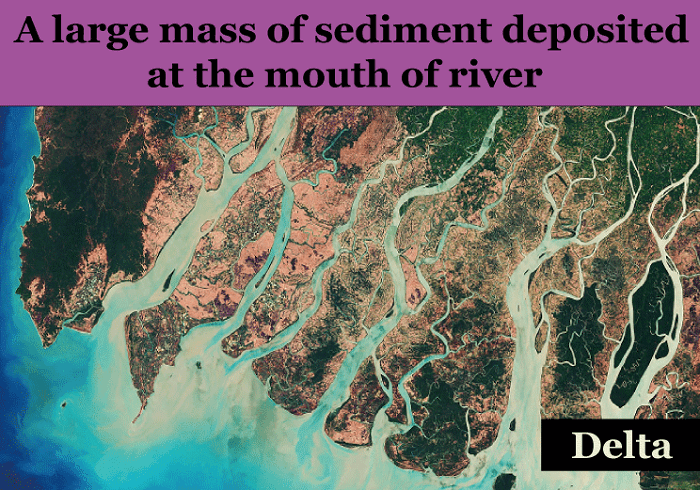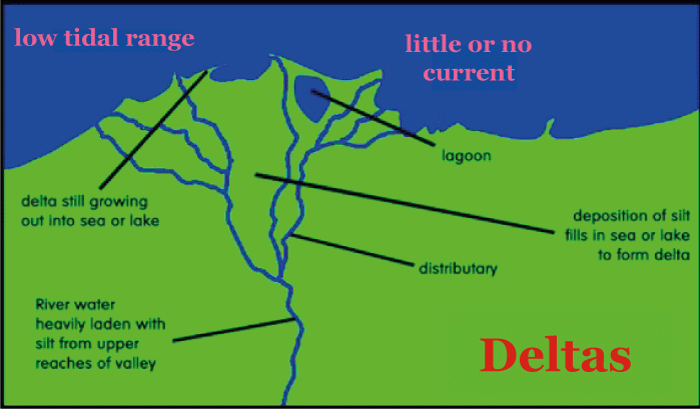Delta DefinitionIntroductionDeltas are wetlands that form when rivers empty their sediment and water into another body of water, such as the ocean, a lake, or another river. Deltas can also empty into the land, although this is quite uncommon. As a river gets closer to its mouth or end, its speed slows, and sediment accumulates, allowing it to leave its single channel. A river can form a deltaic lobe under the best conditions. A mature deltaic region has a network of distributaries, which are smaller, shallower waterways that diverge from the river's main channel. Larger, heavier particles settle first in a deltaic lobe. Finer, smaller silt is carried further downstream. Past the river's mouth, the best material is dumped. Alluvium or silt is the name of this substance. Silt is nutrient-rich, aiding the growth of microorganisms and plants?the producers in the food chain. 
New land is generated as the silt accumulates. A river's mouth is extended into the body of water it flows into by a delta. Subaerial and subaqueous regions can be separated into separate portions of a delta. A delta's subaqueous region is submerged. The finest silt is found here, the delta area that slopes steeply. The delta is the newest section of the subaqueous delta, located the farthest from the river's mouth. A delta's subaerial region is above water. The lower delta is the subaerial zone most affected by tides and waves. The upper delta is where the river's flow has the most impact. This nutrient-rich wetland in the upper and lower delta may be a continuation of the river bank or a collection of small islands in the middle of the river's distributary network. Like the majority of wetlands, deltas are very diverse and significant biologically. Deltas take in runoff from storms (from lakes or the ocean) and floods (from rivers). When water slowly moves through the distributary network of the delta, it also gets filtered. By doing this, the effects of pollution coming from upstream can be lessened. Deltas are significant wetland habitats as well. Deltas are home to plants like lilies and hibiscus and herbs like wort, which are utilized in conventional medicine. The shallow, ebbing waters of a delta are home to various animals. The ecosystem of a delta can include fish, crustaceans like oysters, birds, insects, or even apex predators like tigers and bears. Rivers only sometimes form deltas. A river's flow must be slow and constant enough for the sediment to be deposited and accumulated before a delta can form. One of the world's swiftest rivers is the Ok Tedi in Papua New Guinea. This river joins the Fly River as a tributary. (The Fly, however, creates a rich delta when it empties into the Pacific Ocean's Gulf of Guinea). If big waves impact a river, it will not create a delta. Huge volumes of silt are dumped into the Pacific Ocean via the Columbia River in the US and Canada. Still, the material is quickly swept away by powerful waves and currents. Tides also restrict delta formation. There is no delta on the Amazon, the biggest river in the world. Silt cannot form a delta on the Amazon due to the Atlantic Ocean's powerful tides. Types of DeltasThere are primarily two ways to categorize deltas. The first considers the factors that led to the landform, while the second considers its shape. InfluenceAccording to the mechanisms that regulate the accumulation of silt, there are four basic types of deltas:
The size and shape of a delta depend on the direction and magnitude of the waves in a wave-dominated delta. Waves formed the Senegal Delta and the Nile Delta from the Atlantic and Mediterranean oceans, respectively. Deltas dominated by tides typically develop in regions with a wide tidal range or between low and high tides. The vast Ganges-Brahmaputra delta, which covers Bangladesh and India, was mostly sculpted by the Bay of Bengal's tides, which rise and fall throughout the year. Gilbert deltas result from massive, coarse sediments being deposited by rivers. Gilbert deltas often only occur when rivers flow into freshwater lakes. They are typically steeper than a wave- or tide-dominated delta's typical flat plain. Estuarine deltas develop when a river creates an estuary rather than flowing directly into the ocean. A brackish (part-freshwater, part-saltwater) ecosystem is found in an estuary, a partially enclosed wetland. As it approaches the Bohai Sea off the coast of northern China, for instance, the Yellow River creates an estuary. ShapeThe Greek letter delta, which has a triangle-like shape in upper case, is where the term "delta" originates. Arcuate (arc-like) deltas have this triangular or fan shape. When the Nile River empties into the Mediterranean Sea, it creates an arcuate delta. Stronger waves produce a cuspate delta, which is tooth-shaped and more pointed than an arcuate delta. In Rome, Italy, the Tiber River empties into the Tyrrhenian Sea and creates a cusp delta. 
Not every delta has a triangle-like form. A bird-foot delta resembles a bird's foot because it contains few, widely spaced distributaries. A bird-foot delta is created when the Mississippi River empties into the Gulf of Mexico. The inverted delta is another delta that doesn't appear conventional. A single stream travels to the ocean or other bodies of water, while the distributary network of an inverted delta is located inland. Northern California's Sacramento-San Joaquin River delta is inverted. The Carquinez Strait, a single gap in the Coast Range, is where the creeks and rivers of the Sacramento and San Joaquin distributary networks converge before heading to the Pacific Ocean. Deltas in the interior that drain into a plain are incredibly uncommon. The Okavango Delta in Botswana is probably the most well-known, which is so extraordinary that it is listed as one of the "7 Natural Wonders of Africa." The Okavango River's water never flows into another body of water. The Kalahari Desert's delta deposits water and sand on a level plain before evaporating. An abandoned delta occurs when a river creates a new channel, leaving the previous one to dry up or stagnate. This action is referred to as avulsion. Avulsion happens when a channel's slope declines and silt accumulation rises. Due to these forces, the channel can break its levees or banks and take a steeper, more direct path to the ocean or other bodies of water. Delta lobe switching refers to the avulsion process that occurs in deltaic lobes. Delta switching has the potential to develop completely new deltaic lobes over time. During the last 5,000 years, delta flipping has caused the Mississippi River to divide into seven or eight deltaic lobes. Deltas and PeopleDeltas are incredibly important to the human geography of a region. For example, they are significant locations for trade and business. Vancouver, British Columbia, Canada's thriving capital, is located on the Fraser River's delta, where it flows into the Strait of Georgia, a section of the Pacific Ocean. The Fraser Delta contributes to Vancouver's status as one of the busiest, most international ports in the world, where imports and exports of products from all over the world occur. Another densely populated river delta is the 'Pearl River Delta', the Delta of Guangdong. One of the economic hubs of China with the quickest growth is the Pearl River Delta. The former British colonies of Hong Kong and Macau, two special administrative areas of China, are located in the Pearl River delta. Hong Kong and Macau offer access to the Chinese market and are friendly to Western enterprises. As people move to the Pearl River Delta region for better living and greater earnings, the area is expanding so swiftly that labor shortages are frequent. As silt accumulates abundantly in deltas, they are typically fertile agricultural regions. The Ganges-Brahmaputra delta, located in India and Bangladesh and draining into the Bay of Bengal, is the biggest in the world. The vast majority of Bangladesh is located on this delta. The main agricultural products of the delta are fish and other seafood, as well as crops like rice and tea. Similarly, one of the most agriculturally productive regions in the United States is the inverted delta formed by the Sacramento & San Joaquin Rivers in northern California. Everything from wine grapes to rice to asparagus and zucchini can be grown in the soil. Disappearing DeltasDeltas are in danger from extensive river management. River management monitors and controls a river's flow (often through dams). River management expands the area used for agriculture or industry and regulates access to water for irrigation, industry, and drinking. When putting delta wetlands at risk, engineers and government representatives must constantly weigh the interests of agriculture, industry, the environment, citizen safety, and health. For instance, in Egypt, river management has significantly changed how land is cultivated along the Nile Delta. The regular flooding of the delta was lessened after the Aswan Dam was built in the 1960s. Due to the inundation, nutrients and silt were dispersed along the Nile's banks. Egypt is now far more dependent on irrigation and fertilizers. The 'Aswan Dam' and other river control strategies are also causing the Nile Delta to contract. The tides of the 'Mediterranean Sea' erode the delta quicker than the Nile can replenish it because it lacks sand and other sediments to strengthen it. The Colorado River in the United States can not reach its delta in Mexico at the Sea of Cortez due to dams. The ecosystem, once the largest desert estuary in the world, now only covers a small portion of its former size, and many native species are at risk of extinction. Lastly, due to decades of river control, the Mississippi River cannot flow freely through the wetlands in its delta. The Mississippi Delta is receding as well, just like the Nile Delta. Creating Louisiana's New Map estimates that between 1990 and 2000, wetland loss annually amounted to 62 square kilometers (24 square miles), or roughly one football field of mud swept into the Gulf of Mexico every 38 minutes. This circumstance exacerbated the destruction brought on by Hurricane Katrina in 2005.
Next TopicDesert Definition
|
 For Videos Join Our Youtube Channel: Join Now
For Videos Join Our Youtube Channel: Join Now
Feedback
- Send your Feedback to [email protected]
Help Others, Please Share









